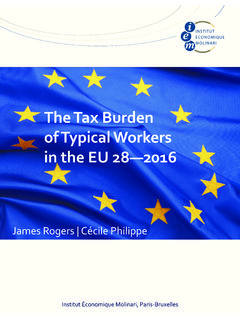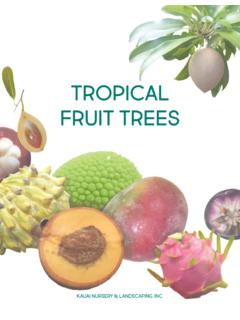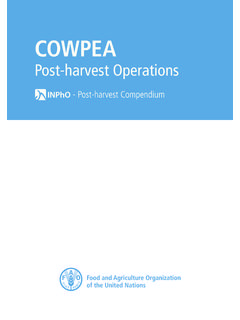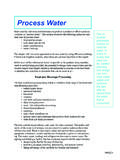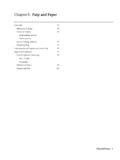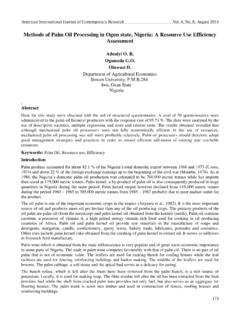Transcription of Economic Note EPTEMBER The health, environmental and ...
1 Palm oil has long been denigrated by its opponents (who were often historically producers of potential alternatives) as being "impure, unhealthy, outright dangerous, and a threat to the environment."4 As with all other agricultural productions in history, palm oil production takes place on formerly "wild" land. Western non governmental organizations (NGOs) such as Friends of the Earth and Greenpeace have been especially active in denouncing the expansion of this industry as the cause of massive deforesta tion and the extermination of charismatic species such as In the meantime, the World Wildlife Fund pub lished its "Palm Oil Buyers' Score Card 2011" which assessed the palm oil buying practices of 132 major retailers and consumer goods manufac Their campaigns have affected many corporate policies.
2 Nestl excluded the Indonesian paper and palm producer Sinar Mas Agro Resources and Technology from its supply chain. Since 2010 Carrefour has purchased Green Palm certified oil for its own brand products sold in France and has committed itself to purchasing only Certified Sustainable Palm Oil by For its part, Casino banned palm oil from all its food products for health considerations while committing itself to purchasing only certified "sustainable" sup plies for its other ( , non food) products. However, we will argue that while not perfect, palm oil displays a number of advantages over actual and potential alternatives in terms of its versatility, productivity, price and volume availability that does indeed make it a superior product in many respects.
3 Boycotting palm oil would fail to deliver any environmental and Economic benefits while severely hurting the growth prospect of impoverished communi ties. HEALTH AND NUTRITIONAL VALUE Commercial palm oil is extracted from the fruit of the oil palm tree (Elaeis guineensis) native to West Africa, a botanical relative of the Palm oil use goes back at least 5,000 years to ancient Egypt,9 but only became a truly global commodity over a century ago when its production took off in other parts of the world characterized by tropical climates with high annual rainfall located within 10 of the The oil palm produces two very different types of oils.
4 Crude palm oil (CPO) from the fibrous meso carp11 and crude palm kernel oil (CPKO) from seed kernels whose composition is actually closer to coconut Between 80 and 90% of palm oil production is destined for human food consump tion either as frying and cooking oil or as an ingre dient in a wide range of food products. The remaining 10% is consumed by various industries, from biodiesel to cosmetics and pharmaceutical producers. The most unique property of palm oil when compared to its most common alternatives (typically rapeseed and soybean oils) is that it is semi solid at room temperature with a specific origin melting point between 33 C to 39 C, which derives from its about 1:1 ratio of un saturated to saturated fatty In practice, it makes it very easy to work with.
5 The health, environmental and Economic benefits of palm oil IEM s Economic Note SEPTEMBER 2012 1 by Hiroko Shimizu, associate researcher at the Institut conomique Molinari by Pierre Desrochers, associate professor at the Department of Geography by University of Toronto Mississauga Oils and fats have been essential components of human life for thousands of years, whether as a source of food, illumination, soap, or as lubricants for At the turn of the 20th century, improvements in refining technologies and long distance transportation turned palm oil into a globally traded commodity and a dominant force in the global vegetable oil According to USDA data, in 2011/12 palm oil contributed of the world vegetable oil supply, the bulk of which (above 85%) was produced in Malaysia and 1.
6 Berger, K. G and S. M. Martin. 2000. Palm oil. The Cambridge World History of Food. In Eds. Kenneth F. Kiple and Kriemhild Cone Ornelas. Cambridge University Press. Chapter II. E. 3. p. 397. 2. Ibid. 3. USDA Foreign Agriculture Service. Production, Supply and Distribution Online. The nine major vegetable oils in this dataset are coconut, cottonseed, olive, palm, palm kernel, peanut, rapeseed, soybean, and sunflower oil. 4. Gustafsson, Fredrik. 2007. The Visible Palm: Market Failures, Industrial Policy and the Malaysian Palm Oil Industry.
7 Almqvist & Wiksell International. p. 87 5. Greenpeace. 2007. Cooking the Climate. Greenpeace UK Report. oil_cooking the climate/ 6. WWF. 2011. Palm Oil Buyers' Score Card. Measuring the Progress of Palm Oil Buyers. 7. Roundtable on Sustainable Palm Oil. 2012. Carrefour Launches First RSPO Trademarked Cooking Oil in Indonesia, RSPO newsletter, July 12. 8. Wood. B. J. 1987. Growth and production of oil palm fruits In Gunstone. F. D. ed. , Palm oil. Critical Reports on Applied Chemistry Volume 15. John Wiley & Sons. p. 12. 9.
8 Berger, K. G and S. M. Martin. 2000. 10. Wood. B. J. 1987. p. 16. 11. Only olive oil and palm oil are extracted from the mesocarp ( , the fleshy middle layer of the pericarp of a fruit, between the exocarp and the endocarp). 12. O'Keefe, Sean Francis. 2000. An Overview of Oils and Fats with a Special Emphasis on Olive Oil. The Cambridge World History of Food. Eds. Kenneth F. Kiple and Kriemhild Cone Ornelas. Cambridge University Press. p. 381. 13. It contains 40% oleic acid (monounsaturated fatty acid), 10% linoleic acid (polyunsaturated fatty acid), 45% palmitic acid and 5% stearic acid (saturated fatty acid).
9 Malaysia Palm Oil Council. Palm oil has often been accused of being less healthy than other alter natives. To better understand the issue, however, one must first get acquainted with some basic nutritional facts. Fats consist mainly of four types of fatty acids: polyunsaturated fatty acids (PUFA), monounsaturated fatty acids (MUFA), saturated fatty acids (SAFA) and trans fatty acid (TFA). In France and elsewhere, the use of palm oil in food preparation has been criticized because it con tains saturated fatty acids which can increase unhealthy LDL choles terol levels.
10 15 However, palm oil is a healthier source of solid fats than hydrogenated vegetable oils. Contrary to soybeans or rapeseed oils which need to be hydrogenated in order to become solid or semi solid, palm oil is already solid at room temperature and is thus less prone to oxidation. It is in the process of partial hydrogenation that artificial trans fatty acids are formed. The intake of trans fats has been linked to heart disease, increased levels of unhealthy LDL (low density lipoprotein) cholesterol and lowered levels of good HDL (high density lipoprotein) cholesterol.


